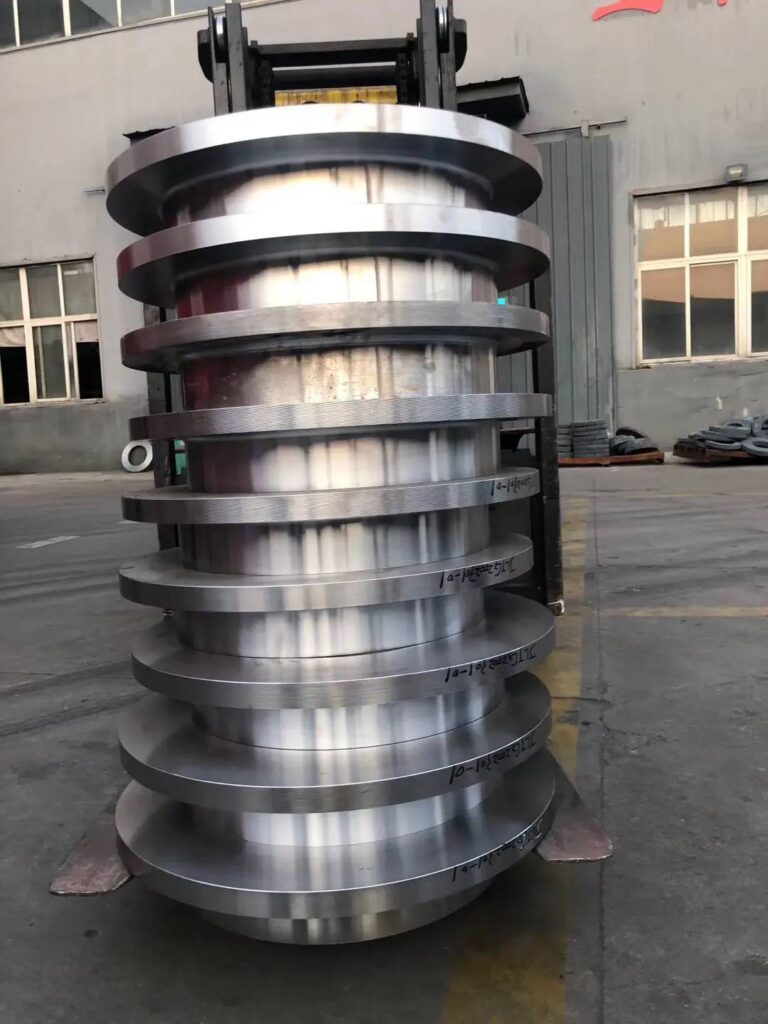The forging process for ring blanks, or circular forgings, is widely used in various industries, including aerospace, automotive, energy, and heavy machinery. Forging enhances the material properties of the metal, making it stronger and more durable, while also providing greater precision in terms of shape and dimensions. In this article, we will explore the key characteristics of the forging process for ring blanks and why it is preferred for manufacturing high-performance components.
1. Uniform Grain Structure and Material Distribution
One of the primary advantages of forging ring blanks is the ability to achieve a uniform grain structure. During the forging process, the metal undergoes deformation under high pressure, which aligns the internal grain structure. This results in a finer and more uniform grain flow throughout the part.
This uniform grain distribution significantly enhances the mechanical properties of the ring blank, such as increased strength, toughness, and fatigue resistance. The improved grain structure allows the forging to withstand heavy loads and stress, making it ideal for high-performance applications like gears, bearings, and pressure vessels.
2. Superior Mechanical Properties
The mechanical properties of forged ring blanks are superior compared to parts produced through other manufacturing methods, such as casting or machining. Forging improves the tensile strength, ductility, and impact resistance of the metal. The combination of high pressure and controlled deformation during forging creates a denser material, reducing the risk of internal defects such as porosity or voids.
These enhanced properties make forged ring blanks ideal for use in critical applications where reliability and durability are crucial. Industries such as aerospace, oil and gas, and energy generation rely heavily on forged components due to their exceptional performance under extreme conditions.
3. High Precision and Dimensional Accuracy
Forging processes, especially modern closed-die or precision forging, offer excellent control over the final dimensions of the ring blank. Manufacturers can achieve tight tolerances and consistent shapes with minimal variation. This precision reduces the need for extensive post-processing or machining, leading to lower production costs and shorter lead times.
Additionally, the ability to control dimensional accuracy during forging ensures that the parts fit correctly in their respective assemblies. This is particularly important for industries that demand high precision, such as the automotive and aerospace sectors, where even small deviations in size can impact the performance of the final product.

4. Improved Fatigue and Wear Resistance
Ring blanks produced through forging typically have improved fatigue and wear resistance compared to cast or machined parts. The forging process consolidates the metal, minimizing internal defects and creating a stronger, more homogeneous structure. This makes forged components less susceptible to fatigue failure or wear over time, even under repeated loading and stress.
These characteristics are especially important for applications where components are exposed to constant mechanical loads or harsh environmental conditions, such as in mining, transportation, and industrial machinery. The enhanced durability of forged ring blanks ensures a longer service life and reduced maintenance requirements.
5. Customization and Versatility
The forging process allows for significant customization in terms of size, material, and design of ring blanks. Different forging methods, such as open-die, closed-die, and seamless rolled ring forging, offer flexibility in producing components that meet specific design and performance criteria. Manufacturers can tailor the forging process to achieve desired characteristics, whether for small, precise components or large, high-strength parts.
Furthermore, a wide variety of materials can be forged, including carbon steel, alloy steel, stainless steel, and exotic metals like titanium or nickel-based alloys. This versatility makes forging suitable for a wide range of applications across different industries.
6. Efficient Material Use
Forging processes typically have higher material utilization rates than other manufacturing methods like machining, where significant material is lost during cutting or shaping. In forging, the metal is deformed rather than removed, which leads to less waste and a more efficient use of raw materials. This makes forging an environmentally friendly and cost-effective production method.

The forging process for ring blanks offers numerous advantages that make it a preferred method for producing high-performance components. From the uniform grain structure and enhanced mechanical properties to precision, fatigue resistance, and customization, forged ring blanks deliver exceptional quality and reliability. These characteristics make forged components indispensable in industries where strength, durability, and precision are critical.
By choosing forged ring blanks, manufacturers can ensure that their products will perform reliably in even the most demanding applications, helping to reduce downtime, lower maintenance costs, and increase the overall lifespan of critical components.
